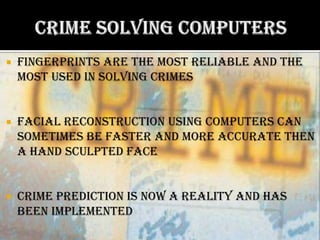The Power of Reverse Engineering in Solving Crimes

Executive Summary

Reverse engineering is a powerful tool that can be used to solve crimes. By working backward from a crime scene or a criminal’s actions, investigators can piece together what happened and identify the perpetrator. This article explores the different ways that reverse engineering can be used to solve crimes, including analyzing physical evidence, profiling criminals, and tracing their movements.

Introduction
Reverse engineering is the process of taking something apart to figure out how it works. This process can be used in a variety of fields, including engineering, computer science, and forensics. In forensics, reverse engineering can be used to solve crimes by working backward from the evidence to find out what happened.
Physical Evidence Analysis
One of the most common ways that reverse engineering is used to solve crimes is through the analysis of physical evidence. This can include things like fingerprints, DNA, blood, and fibers. By analyzing this evidence, investigators can determine who was at the crime scene and what happened.
Analytical Techniques for Physical Evidence Analysis:
- High-resolution imaging: This involves obtaining highly detailed images, subject to different light sources and angles, to detect trace evidence.
- 3D scanning: This allows for precise collection and digitization of crime scene data in complex environments.
- Microscopic analysis: Examination at the microscopic level helps identify and characterize specific elements and substances.
- Chemical analysis: Investigating the chemical makeup of evidence can reveal the presence of controlled substances, explosives, or toxins.
- DNA profiling: DNA extraction and genetic sequencing help link DNA profiles from a crime scene to a specific individual.
Profiling
Another way that reverse engineering can be used to solve crimes is through profiling. This involves creating a psychological profile of a criminal based on their actions and behavior. This profile can then be used to identify potential suspects and track down the perpetrator.
Criminal Profiling Techniques:
- Offender Typology: This involves placing the offender into a certain category based on their motivations and modus operandi.
- Victim Profiling: Assessing the victim’s characteristics and circumstances to understand the offender’s selection process.
- Linkage Analysis: Identifying connections between seemingly unrelated crimes or offenders by examining patterns.
- Geographic Profiling: Analyzing the spatial distribution of crimes to determine the offender’s location patterns.
- Behavioral Analysis: Studying an offender’s behavior and mindset during the crime to understand their thought process.
Tracing Movements
Reverse engineering can also be used to trace a criminal’s movements before and after a crime. This can be done by analyzing cell phone records, security camera footage, and eyewitness accounts. By piecing together this information, investigators can determine where the criminal was and what they were doing at the time of the crime.
Locating Techniques:
- Cellular Data Analysis: This involves examining cell phone records to understand the user’s location, movements, and communications.
- GPS Data Analysis: Analyzing GPS data from devices to track the user’s travel patterns and previous whereabouts.
- Digital Footprint Analysis: Examining a suspect’s online presence, including social media accounts and website visits to monitor their activities.
- Surveillance Camera Analysis: Reviewing footage from security cameras in public spaces and business premises to identify suspects and track their movements.
- Witness Testimonies: Gathering eyewitness accounts to help reconstruct the chain of events and look for discrepancies.
Conclusion
Reverse engineering is a powerful tool that can be used to solve crimes. By working backward from the evidence, investigators can piece together what happened and identify the perpetrator. This article has explored the different ways that reverse engineering can be used to solve crimes, including analyzing physical evidence, profiling criminals, and tracing their movements.
Keyword Phrase Tags:
- Reverse engineering in forensics
- Crime scene analysis
- Criminal profiling
- Tracing criminal movements
- Solving crimes using evidence

How has reverse engineering solves crimes? Can you give me an exemple how this has solved a crime?
This is very interesting! I can see how reverse engineering is very important and can solve crimes..
Reverse engeenering has been used for quite some times and has helped to solve numerous crimes, but i agree that it not be able to solve every situations.
The title should have been
“The Power Of Reverse Engineering In Solving Some Crimes”.
This is not possible to used in every situations.
I’m not sure i understand how reverse engineering is used, could you explain it wih a simple word?
Wow, reverse engineering, is this a new technology? or has it been used in the stone age?
I want to know how to use this reverse engineering thing, so i can become a detective
I know that reverse engineering has been used to break softweres and games copy protections, can it be used to solve other crimes?
This could have been a better article if it wasn’t for all the syntax errors and typos.
This Reverse engineering sounds like an effective methods for solvings most crimes. However, I wonder how efficient it can be in revealing white-collar crimes.